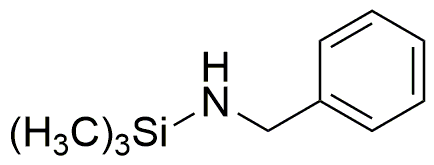N-Benzyltrimethylsilylamine is widely utilized in research focused on:
- Synthetic Organic Chemistry: It serves as a versatile reagent in the synthesis of various organic compounds, facilitating the formation of carbon-nitrogen bonds, which are crucial in drug development.
- Silicon-Based Materials: This compound is employed in the preparation of silicon-containing polymers and materials, enhancing their thermal stability and mechanical properties, beneficial for the electronics and automotive industries.
- Pharmaceutical Applications: It plays a role in the development of pharmaceutical intermediates, providing a pathway for the synthesis of active pharmaceutical ingredients (APIs) with improved efficacy.
- Analytical Chemistry: Used as a derivatizing agent in gas chromatography, it improves the detection and quantification of amines and other polar compounds, making it invaluable in environmental and food safety testing.
- Research in Catalysis: It is involved in catalyzing various chemical reactions, offering advantages in selectivity and yield compared to traditional catalysts, thus streamlining research processes in chemical engineering.
General Information
Properties
Safety and Regulations
Applications
N-Benzyltrimethylsilylamine is widely utilized in research focused on:
- Synthetic Organic Chemistry: It serves as a versatile reagent in the synthesis of various organic compounds, facilitating the formation of carbon-nitrogen bonds, which are crucial in drug development.
- Silicon-Based Materials: This compound is employed in the preparation of silicon-containing polymers and materials, enhancing their thermal stability and mechanical properties, beneficial for the electronics and automotive industries.
- Pharmaceutical Applications: It plays a role in the development of pharmaceutical intermediates, providing a pathway for the synthesis of active pharmaceutical ingredients (APIs) with improved efficacy.
- Analytical Chemistry: Used as a derivatizing agent in gas chromatography, it improves the detection and quantification of amines and other polar compounds, making it invaluable in environmental and food safety testing.
- Research in Catalysis: It is involved in catalyzing various chemical reactions, offering advantages in selectivity and yield compared to traditional catalysts, thus streamlining research processes in chemical engineering.
Documents
Safety Data Sheets (SDS)
The SDS provides comprehensive safety information on handling, storage, and disposal of the product.
Product Specification (PS)
The PS provides a comprehensive breakdown of the product’s properties, including chemical composition, physical state, purity, and storage requirements. It also details acceptable quality ranges and the product's intended applications.
Certificates of Analysis (COA)
Search for Certificates of Analysis (COA) by entering the products Lot Number. Lot and Batch Numbers can be found on a product’s label following the words ‘Lot’ or ‘Batch’.
*Catalog Number
*Lot Number
Certificates Of Origin (COO)
This COO confirms the country where the product was manufactured, and also details the materials and components used in it and whether it is derived from natural, synthetic, or other specific sources. This certificate may be required for customs, trade, and regulatory compliance.
*Catalog Number
*Lot Number
Safety Data Sheets (SDS)
The SDS provides comprehensive safety information on handling, storage, and disposal of the product.
DownloadProduct Specification (PS)
The PS provides a comprehensive breakdown of the product’s properties, including chemical composition, physical state, purity, and storage requirements. It also details acceptable quality ranges and the product's intended applications.
DownloadCertificates of Analysis (COA)
Search for Certificates of Analysis (COA) by entering the products Lot Number. Lot and Batch Numbers can be found on a product’s label following the words ‘Lot’ or ‘Batch’.
*Catalog Number
*Lot Number
Certificates Of Origin (COO)
This COO confirms the country where the product was manufactured, and also details the materials and components used in it and whether it is derived from natural, synthetic, or other specific sources. This certificate may be required for customs, trade, and regulatory compliance.

